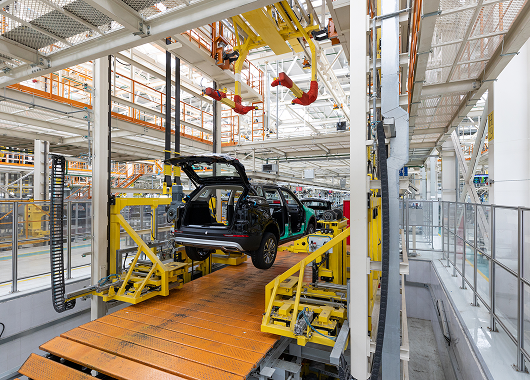
The Evolution of Lifting Equipment Evolution
Share
Throughout human history, our ability to lift heavy objects has played a pivotal role in shaping civilizations. From primitive tools that relied on human or animal power to today’s state-of-the-art, computer-controlled cranes and lifts, the evolution of lifting equipment mirrors humanity’s continuous quest for efficiency, safety, and innovation.
In this blog post, we explore the fascinating journey of lifting equipment—from its humble beginnings in ancient civilizations to the high-tech, automated systems of today.
Ancient Beginnings: The Birth of Lifting Devices
Long before the advent of modern machinery, ancient engineers developed ingenious methods to overcome gravity’s challenge. Early devices like the shadouf—a simple lever and pulley system used for irrigation in ancient Mesopotamia and Egypt—allowed people to lift water and other heavy materials with minimal human effort. Such early inventions laid the groundwork for more complex systems.
The ancient Greeks further advanced lifting technology by introducing rudimentary cranes. Evidence from temple constructions suggests that cranes, powered by human or animal strength, were used to hoist massive stone blocks into place. This not only revolutionized architectural design but also demonstrated the timeless utility of basic mechanical principles like the lever and pulley.
Medieval Innovations: Rebirth and Reinvention
After the decline of ancient empires, Europe experienced a period where much of this technical knowledge was lost. However, during the Middle Ages, a resurgence in architectural ambition—evident in the construction of Gothic cathedrals and castles—sparked the reinvention of lifting devices.
Medieval engineers reintroduced the treadwheel crane, a human-powered mechanism that resembled a giant hamster wheel. Workers would walk inside the wheel to turn a central axle, effectively lifting heavy loads vertically. These machines, often constructed of wood, were not only practical but also became iconic symbols of medieval ingenuity.
In harbors and construction sites alike, cranes began to play a critical role in the efficient movement of materials. Innovations such as the windlass and capstan further enhanced these early lifting devices, allowing for greater loads and more precise operations.
The Industrial Revolution: Powering Up the Future
The onset of the Industrial Revolution marked a turning point in the history of lifting equipment. With the development of steam power and later hydraulic systems, machines were no longer bound by the limits of human or animal strength.
Inventors like William Armstrong revolutionized lifting technology by creating water-powered hydraulic cranes. These machines could lift heavy industrial loads with remarkable efficiency—paving the way for modern construction and maritime operations. Hydraulic accumulators and other innovations allowed cranes to operate with a level of precision and power that had never before been seen, fundamentally transforming industries worldwide.
Modern Advancements: Smart, Safe, and Sustainable
In the 20th and 21st centuries, lifting equipment underwent another significant transformation. The advent of electricity and digital technology ushered in an era of smart cranes and lifts. Today, many modern cranes are equipped with:
-
Hydraulic and Electric Systems: These systems provide smoother, more controlled movements while increasing lifting capacity.
-
Automation and AI: Smart sensors and computer controls enable real-time monitoring, predictive maintenance, and even autonomous operation—boosting safety and efficiency.
-
Enhanced Safety Features: Modern designs incorporate redundant systems, advanced braking, and operator cabins designed to minimize risk.
-
Eco-Friendly Innovations: With growing environmental concerns, manufacturers are increasingly turning to electric and hybrid-powered equipment to reduce emissions and lower energy consumption.
A recent industry blog highlights these advancements and envisions a future where lifting equipment not only meets the demands of modern construction but also plays a role in sustainable development.
Looking Ahead: The Future of Lifting Equipment
As technology continues to evolve, the future of lifting equipment promises even greater strides in efficiency and safety. Emerging trends include:
-
Increased Automation: Autonomous cranes and lifts are expected to become more prevalent, reducing human error and enhancing productivity.
-
Integration with IoT: Connected devices will enable seamless communication between equipment and operators, leading to smarter, data-driven decisions.
-
Advanced Materials: The use of lightweight, durable materials such as carbon fiber and nano-engineered composites could further improve performance while reducing energy usage.
-
Sustainable Energy Sources: As the world shifts towards greener technologies, innovations in battery and fuel cell systems will help lift trucks and cranes run cleaner and more efficiently.
Conclusion
From the simple shadouf to today’s high-tech smart cranes, the evolution of lifting equipment is a testament to human ingenuity. Each era has built upon the innovations of the past, driving progress through a relentless pursuit of improvement. As we look to the future, the next generation of lifting equipment will undoubtedly continue this legacy—making our built environment safer, more efficient, and more sustainable.
Stay tuned for more insights into industrial technology trends as we continue to explore the machinery that keeps our world moving.

